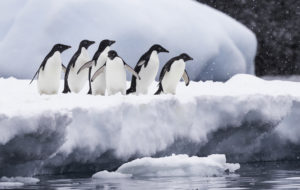On a One Ocean Expeditions voyage, admiring, observing and learning about bird life is one of the many important facets to our expeditions. In honour of World Migratory Bird Day on May 11th, we thought we’d give you a brief introduction to the world of migratory birds.
The oldest method for studying bird migration is observation. Aristotle observed and compiled a list of over 170 different bird species and their patterns in 350 BC. Up until that time, it was assumed that birds went into hibernation in the winter time, it wasn’t until Aristotle proposed that the absence of many birds in the winter wasn’t hibernation, but migration. However he only proposed this for some species, and firmly believed that others, such as swallows, still hibernated. It wasn’t until late in the 18th century that migration as an explanation for the winter disappearance of birds from northern climes was widely accepted.
As summer arrives in the Arctic and Antarctic, so do migrant birds that travel to breed, nest and enjoy the nutrient-rich waters. The origins of long-distance migration patterns have evolved over thousands of years, controlled at least partially by the genetic makeup of birds and also incorporating responses to weather, geography, food sources, day length and other factors.
A sea bird famous for long distance migrations between the North and South Poles, the Arctic Tern makes a return trip of around 44,000 miles from pole to pole each year, which is the equivalent of three round trips to the Moon in its lifetime. Flying between its breeding grounds in Greenland in the north and the Weddell Sea in the south, terns spend their lives in perpetual ‘summer’ and have the longest migration ever recorded at 59,650 miles.

The Wilson’s Storm Petrel also travels huge distances, breeding on the islands and cliffs of the Antarctica region and migrating to the Arctic. At home in the roughest of seas, these birds fly in troughs of waves during gales and are commonly seen off the Atlantic Coast feeding on crustaceans and small fish.
With an average weight of just 1/8 of an ounce, Hummingbirds are the smallest migrating bird. They can travel as fast as 48kph when migrating and can fly nonstop as far as 600 miles.
Flying nearing 15,000kms every year, the Red Knot, tiny with a wingspan of just 20 inches, flies from the southern coast of Chile and Argentina to the Canadian Arctic.
It’s not all about being airborne as flightless birds such as penguins also migrate. The Adélie Penguin has been known to trek an average of 13,000km every year, following the sun from their breeding colony in Antarctica to their winter grounds and back. They walk along the edge of the sea ice to remain close to their food source- krill. Most species of penguin migrate by swimming, covering routes of over 1,000 kilometres.

Most birds migrate in flocks, and in larger birds flying in flocks reduces energy cost. Altering their metabolism to meet the demands of migration, migratory birds will accumulate fat to use as a storage of energy, and moult once or twice a year after suffering from wear and tear on their feathers.
Instinctively, migrating birds know where to migrate and how to navigate back home. 1800 of the world’s 10,00 bird species being long-distance migratory birds, using the sun, the stars and the earth’s magnetism to help them find their way. Almost always returning to the home where they were born, it wouldn’t be surprising to spot the same bird in the same place each year!
Experience migratory birds for yourself by visiting Antarctica or the Arctic with One Ocean Expeditions and travel alongside our expert ornithologists. Speak to your preferred agent or contact us to book your adventure today.















